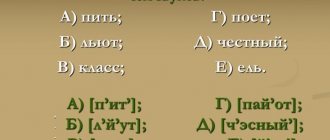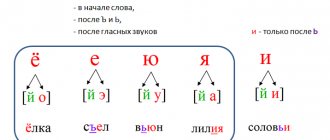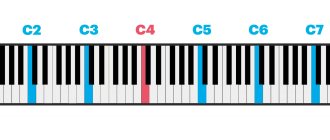A pictogram (from Latin pictus - “drawn” and Greek gramma - “record”, “written sign”) is a drawing-symbol. It depicts some event, object or action .
Pictographs were used even before the advent of writing, for example, in Ancient China and Ancient Egypt.
Nowadays, pictograms are used as signs that facilitate the transfer of information .
For example, as signs on the road or a schematic representation of some other rule, at airports, train stations, in the subway, to indicate functions in computers, etc.
Examples of pictograms
Pictograms can be seen in traffic rules (road signs), on various diagrams, scoreboards, navigation signs, and even in puzzles for children.
Pictogram on the road sign "Tunnel"
You can take a shower in the place where this pictogram is located.
Pictograms indicating sports disciplines
Pictograms at the airport to indicate toilets and mother and baby rooms
A pictogram that indicates where the exit is located
Pictograms for transporting goods
Basic properties of pictographic writing
Pictography has its own characteristics that distinguish it from other types of writing. These include:
- public availability. Pictographic writing is presented graphically and expresses the meaning of a statement. Therefore, the pictograms are understandable to people speaking different languages;
- lack of phonetic and grammatical connection with a specific language. The pictogram can be described in your own words and in different languages. Unlike a letter, it cannot be a linguistic unit;
- a related connection with the nonverbal communication system, but not equal to it. “Sign language” at a certain point became the link between pictography and ideography. The visual sign, taking the form of an abstract concept, becomes the driving force for the emergence of a graphic image of the abstract concept.
Writing skills in children
Overcoming and preventing writing and reading – logo games
Psychophysiological structure of writing and the prerequisites for its formation
Errors in writing - consequences of dysorthography?
How did people “start talking”?
Related posts:
- The psychophysiological structure of writing and the prerequisites for its formation Written speech is the structure of writing and the prerequisites for the formation of writing skills….
- What is "War and Peace" about? Summary of the novel “War and Peace” by chapters. All answers...
- Calligraphic handwriting is the key to competent writing. Developing calligraphic handwriting is the dream of many schoolchildren. But not everyone...
- History, signs and symptoms of dysgraphia Symptoms of dysgraphia in children and methods of overcoming it depend on ...
“Pictogram” technique
This is an experiment using pictograms to help determine whether a person has a mental disorder.
Words and phrases are read to the person, and he must remember them all. To help him, he is given a piece of paper and a pen or pencil.
But neither letters nor numbers can be written down. Words can only be sketched.
Then the sheet is taken from the person and returned only after some time. Looking at his drawings, he must reproduce the words that were read.
This test shows not only how well a person’s memory is developed. But also his way of thinking .
A healthy person will be able to match the image to the word. For a person with a mental disorder, this will cause difficulties.
History of pictography
Pictography is the oldest writing system, which is a collection of images (pictograms). It became the initial stage of the emergence and development of writing.
The first pictograms appeared around the 8th-6th millennia BC. This is a time when there were no letters yet. But people already needed to transmit information to each other through communication at a distance. They left drawings on the walls of their homes, stones, and wood.
This is how the thoughts of primitive individuals were transmitted: their emotions, wishes, fears, warnings.
Thus, they left information about themselves to their descendants. With the help of pictograms, ancient peoples wrote messages about hunting, fighting, love, spells, and left inscriptions on tombstones.
Over time, the number of graphic images became more and more difficult to use. There was a need for canonization of written speech. Then pictographic writing smoothly turned into ideographic writing.
In ideography there are fewer means of expression, but they have a wider application.
Certain objects or phenomena were depicted in the form of several ideograms, each of which could be used for different descriptions. For example, light was represented in the form of images of the sun and moon.
Further, it was necessary to further simplify the writing system, reduce the number of units of written speech and specify the essence of the messages.
It became important to convey all the subtleties of the author’s thoughts to the reader. Syllabic and letter writing systems were gradually formed.
In the 2nd – 1st millennia BC. e. The first alphabet (Phoenician) appeared.
However, there are examples of peoples who still use a pictographic writing system. For example, the Nesi people living in the foothills of Tibet.
Current icons
Civilization does not stand still; the modern generation is practically born with tablets and smartphones. Will they really identify with the old-fashioned telephone we use to represent calls? Do they know that the voicemail icon used by Apple is actually a tape recorder? Do they know what a tape recorder is?
These are the kinds of questions you can ask while looking at your smartphone or computer. These types of icons seem to become ideograms instead of being pictograms—symbols that are finally universally accepted as the official representation of an idea or concept.
Can an ideogram convey the meaning of a word?
The difference between an ideogram and a pictogram is not always clear. An ideogram is an image that looks more like a rebus. Pictograms tend to be more literal.
Ideograms and pictograms were used to create writing systems such as Egyptian hieroglyphs, Sumerian cuneiform, and Chinese characters. However, they are often still logograms, representing words or morphemes of a particular language, rather than objects or concepts. These writing systems used different strategies when designing logos. Pictographic symbols represent the object to which the word refers, such as the bull symbol representing the Semitic word aleph (bull).
Some words denoting abstract concepts can be represented by a symbol, but most others are represented using the rebus principle, borrowing a symbol from a similar-sounding word. Many characters in hieroglyphic as well as cuneiform writing can be used either logographically or phonetically.
They're everywhere
We can see pictograms and ideograms everywhere. They are found on signs along roads, on buildings, train stations, in electronic devices, computers, etc. They convey the necessary information very simply and are understandable to everyone.
Today there are thousands of common pictograms and ideograms, and we recognize them at a glance. Popular examples are email icon, phone icon, play button, download button, etc. Some are pictograms, others are ideograms, and some are a combination of both.
Sometimes a pictogram plays the role of an ideogram. For example, an icon representing the meaning of an idea is represented by a light bulb. Even though the light bulb is actually a representation of an object (a pictogram), it conveys a message of an idea, a concept (an ideogram). The image can be enhanced by rays of light.
A Brief History of Pictograms and Ideograms
Pictograms and ideograms were constantly evolving and were often associated with magical powers. They were used to convey religious ideas or even as a secret code.
These days, so-called icons serve a more utilitarian purpose. Due to the Industrial Revolution and globalization, people around the world are establishing themselves in foreign countries using the same technologies to work and communicate. These are a kind of universal images that help to communicate, regardless of language or culture.
Examples of ideograms: concept
The image of a finger (pointer) is an ideogram. It is a concept, it is not a sequence of sounds and has the meaning: “go this way” or “in this direction” and so on. It can be used in combination with words or other ideograms, such as "stairs on the right" or "pick up your luggage at this place."
These are not necessarily images of objects. The arithmetic minus sign is also an ideogram that depicts a concept that translates to "minus" or "subtract the following from the previous" or "negative value".
Creating an icon is not an easy task for a designer
Because the icon needs to be universal, it can be very difficult for a designer to create a working icon. There are so many things to take into account. For example, the presentation of something can be interpreted differently depending on culture, belief or religion. The use of color is also best avoided. In Europe, the color red is a common symbol of danger, while in China it symbolizes good luck and is believed to protect against evil.
Some ideas are considered impossible to fit into an ideogram without the help of text. Try to imagine the concept of "account manager" as an icon, it's really not an easy task at all. It's also very risky to try to do things differently when creating a new icon. If a triangle in a circle means a game, don't try to reinvent the wheel. It just confuses people. Icons are not always a place for creativity.









